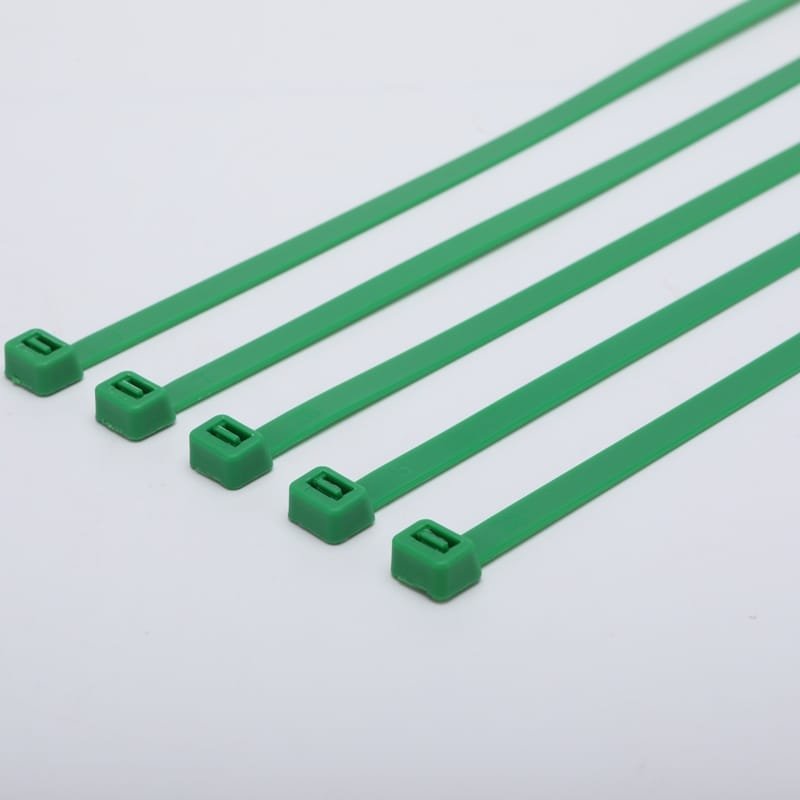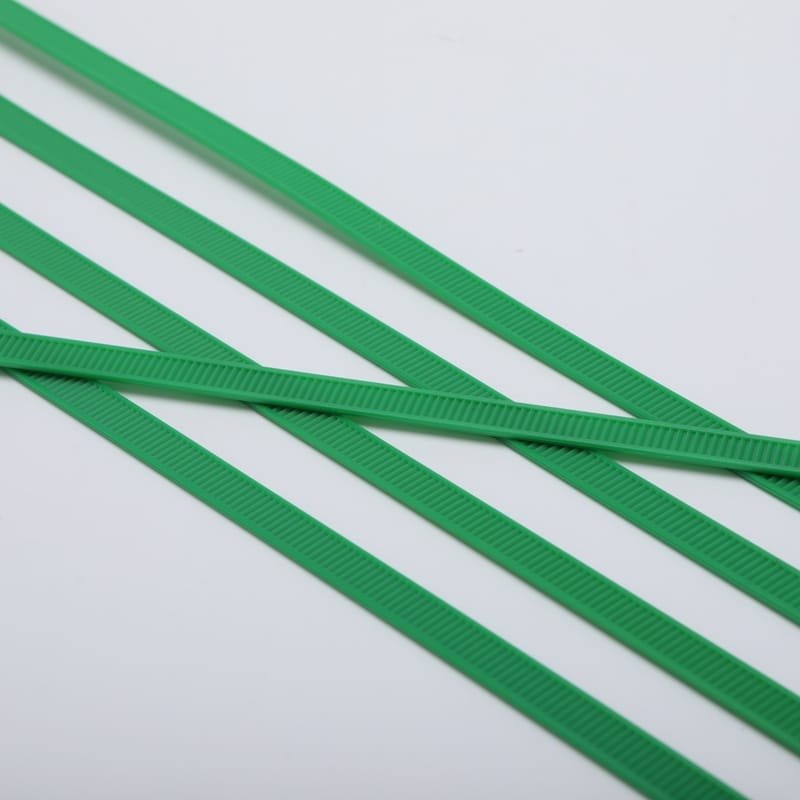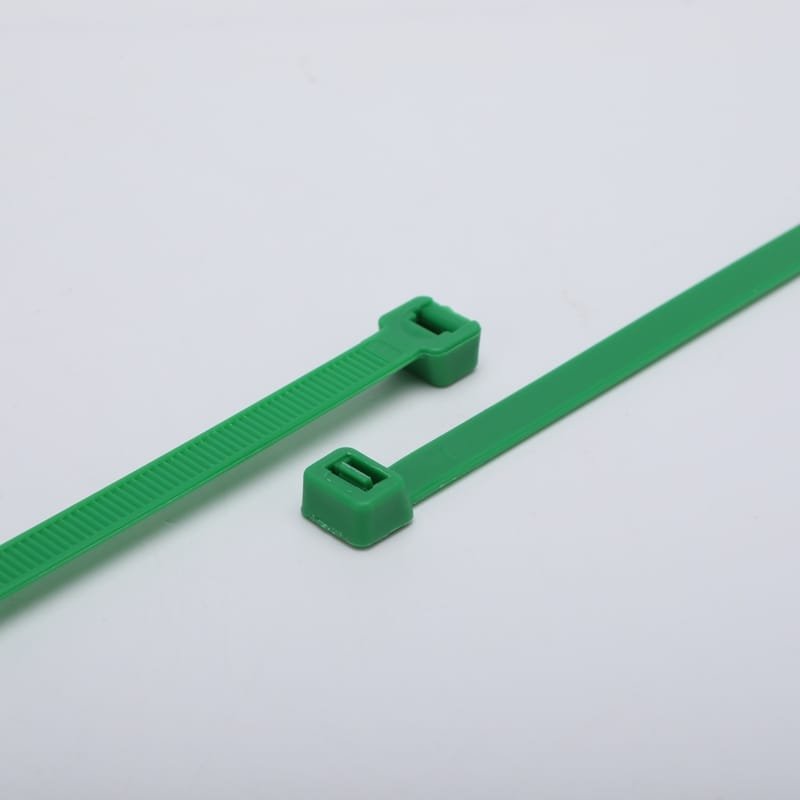What are green zip ties?
Green zip ties, also known as green cable ties or green wire ties, are plastic-based tools for securing bundles. Green, a color that’s both pleasing to the eye and reminiscent of nature, has found widespread use in agricultural and garden decorations, as well as safety markings.
1.Material Description
Nylon 6 (Nylon 6) — nylon cable ties
Hygroscopicity: High water absorption, which may reduce tensile strength in humid environments.
Tensile Strength: Medium strength, suitable for general indoor bundling.
Flame Retardant: Meets UL94 V-2.
Using Temperature: –10°C to 75°C.
Applications: Home, office, and general cable management.
Nylon 6.6 (PA66) —heavy duty green zip ties
Hygroscopicity: Low water absorption, maintaining mechanical properties even when wet.
Tensile Strength: High strength, suitable for applications requiring high load-bearing capacity.
Flame Retardant: UL94 V-2.
Using Temperature: –20°C to 85°C. UV/Aging Resistance: Excellent performance, ensuring long-term outdoor use.
Applicable Applications: Outdoor engineering, power transmission equipment, aviation, and harsh environments.
(Also available as UV resistant green zip ties when formulated with stabilizers.)
Polypropylene (PP) — PP cable ties
Hygroscopicity: Virtually non-water-absorbent, humidity does not affect strength.
Tensile Strength: Less resistant than nylon but stable, suitable for light-load bundling.
Flame Retardant: UL94 HB.
Operating Temperature: 0°C to 85°C.
Chemical Resistance: Excellent resistance to oils, acids, and alkalis.
Applicable Applications: Chemical plants, production lines, and corrosive environments.
2.Product Features
Self-locking green zip ties utilize a one-way ratchet mechanism, with the unidirectional beveled teeth of the nylon strap engaging with the elastic locking tongue at the head. This creates a one-way ratchet mechanism, ensuring a permanent lock upon tightening. Green, a natural, safe, and low-visibility color, has a wide range of applications in both industry and agriculture. For example, in agriculture and gardening, it can be used for decorative bundling of vines or green flowers. It can also serve as a safety marker in fire protection systems and safety equipment management. (Also offered: releasable green cable ties for temporary bundling.)
3.Color Matching Process
You can mail in samples to determine the specific green color, which is ideal. You can also select your desired green at https://www.pantone.com/color-finder. Sending product photos is also acceptable, but color variations may occur. Once the green shade is determined, we will mix the corresponding green masterbatch. This masterbatch will be evenly mixed into the raw materials to ensure uniform color distribution throughout the green cable ties produced. (We support various shades of green in the Pantone color palette, such as dark green cable ties.)
4.Applications
Green cable ties are often used for natural decorations or as safety signs.
4.1Agricultural or Gardening Decorative Zip Ties
Since most plants in the environment are green, green cable ties blend naturally into the environment. For example, in agriculture, securing vines like grapes and cucumbers to racks or trellises is quick, convenient, and aesthetically pleasing. In municipal gardens, for example, maintaining hedges, securing flower arrangements, and installing holiday decorations, they are not only efficient to install but also easy and environmentally friendly to remove. (green cable ties for gardenin)
4.2 Environmental or Safety Marking
In warehouses or logistics management, green cable ties can be used as environmental symbols to indicate recyclable items or green energy equipment; fixed escape route signs ensure visibility in emergencies; and to clearly mark pipelines and equipment that have been inspected or repaired and are safe, creating a clear distinction from red zip ties“danger zones.” (Useful as green safety cable ties for marking and identification.)
4.3 Marking in Line Management
Green wire ties are often used to mark ground wires, helping to safely distinguish them from other lines. During line inspection or maintenance, marking safe or repaired lines reduces operational risks and increases work efficiency. (Commonly specified as grounding green zip ties .)
5.Specifications and Technical Parameters
Width, length, and thickness determine the size of a green cable tie. Width and thickness are directly proportional to tensile strength, while length is directly correlated to the maximum wire diameter. Using nylon 66 as an example for our green cable ties, below are the technical parameters for a small selection of cable tie sizes from our factory.
cable ties sizes
| Type | Length | Width(mm) | Max.Bundle Dia.(mm) | Min tensile strength | ||
| Inch | mm | lbs | Kgs | |||
| WD-3×150 | 6″ | 150 | 2.5 | 35 | 18 | 8 |
| WD-4×150 | 6″ | 150 | 3.6 | 35 | 40 | 18 |
| WD-5×150 | 6″ | 150 | 4.8 | 35 | 50 | 22 |
6.FAQ
Q1: What is the maximum length of cable ties green?
A1: We can provide cable tie green up to 1.2 meters. Of course, if you require a longer length, we can also provide custom molds. (Custom long green zip ties available on request.)
Q2: Can you provide samples?
A2: Please let us know your specific material, color, and size, and we will arrange for our production workshop to produce samples. Samples of commonly used materials and sizes are available free of charge.
Q3: Are green plastic wire ties weather-resistant and UV-resistant?
A3: Ordinary nylon 6 is not UV-resistant. Only products made from modified nylon 66 with added heat-resistant and UV-resistant additives have this property. (If you need UV resistant cable tie green color, please specify PA66 with UV stabilizers.)
7.Why Choose Green Zip Ties?
Zip tie green are used for grounding lines, safety zones, and escape route markings. Through color standardization, they mitigate the risks of high-risk operations. They coordinate with the colors of natural vegetation and engineering equipment, achieving seamless anchoring in agricultural, forestry, and municipal settings, eliminating visual intrusion and maintaining a harmonious connection between landscape and facilities.






